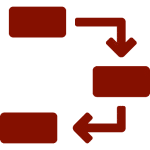
Key takeaways
-
Operational efficiency in service industries depends on optimizing processes, structure, technology, and people; there’s no single silver bullet
-
Adopting lean principles and automation (including digital tools, RPA, workflow technologies) can yield substantial cost- and time-savings, while improving service delivery and reducing waste
-
People and organizational design (governance, workforce planning, leadership, culture) are as critical as processes and technology for sustained efficiency
In this article, we’ll explore all the ways in which you can drive efficiency in your Operations. Why Operations? We chose Operations because it is often the part of an organization where even the smallest of efficiencies can make a big difference. So, let’s explore 111 ways to increase your operational efficiency – we’ve divided them into various themes easily accessible in the list below.
General Operational Efficiency Improvements
- Introduce Shared Services: An operating model that leverages Shared Services is often more efficient than the model where each business area has its own, often redundant functions. A Shared Services setup ensures that the entire organization, including Operations, uses available resources in a pooled and highly efficient way.
- Introduce a Lean Six Sigma (LSS) program: LSS focuses on efficiency improvement through the reduction of variation in processes and output and elimination of waste. Originally born in manufacturing, this program has since been adopted by companies across various industries.
- Focus on Continuous Process Improvement: Continuous process improvement is similar to Lean Six Sigma, however, it lacks the formality of an LSS program. The main idea is a constant improvement of processes, driving new efficiencies using numerous process improvement methods and tools.
- Embrace Lean: Lean methodology strongly focuses on operational efficiency and the elimination of waste throughout an entire process, whatever that process may be. Lean defines various types of waste such as unnecessary inventory, unnecessary transportation, excessive rework, unnecessary work etc. and systematically decreases it.
- Driving change: If the status-quo is not a solution, a change management program driven by change agents (whether they are internal, or external) can energize an entire organization, highlight new ways to do things, and motivate people on the journey to increased efficiency.
- Rework operating model: If your Operations or Back-office is used to always doing things in a certain way, it does not mean that there is not a more efficient way to do those things. Making process changes — including the adjustment of a company’s physical footprint, outsourcing or offshoring of particular processes, changes to organizational structure — can help increase efficiency.
- Consider Outsourcing: In some cases, it is more cost-efficient to hire a third party to perform certain activities. Reasons for this include a lower price point, faster service delivery, and/or special skills that an outsourcing company can offer.
- Off-shore: Off-shoring some activities can drive even stronger price arbitration than outsourcing. Some geographies offer price points that are several times lower than, for example, the price point in North America.
- Leverage analytics: Strong analytical capacity will allow you to slice and dice your operational data, identifying opportunities to make Operations more efficient — such as workforce planning. Furthermore, it can provide important insights into intra-day and mid-/long-term work volumes and required capacity.
Interested in transforming your operations? We can help.
CONTACT US Operational Efficiency and Footprint & Real Estate
Operational Efficiency and Footprint & Real Estate
- Consolidate your physical footprint: Each of your company’s real estate locations (whether leased or owned) drives additional costs. In many cases, eliminating a local office and consolidating its activities into a nearby Operations centre can provide meaningful savings.
- Spread your physical footprint (hub vs satellites): In contrast to the last point, sometimes it is beneficial to have multiple locations. Specifically, where it can provide for savings at the resource level, local language skills or speedier processing times. Having a local ops office that immediately digitizes incoming mail and distributes it can eliminate 1-2 days of mail transfer from the East Coast to the West Coast (such as from Vancouver to Toronto or from Los Angeles to New York and Boston)
- Relocating to a cheaper location: Relocating your Operations to a less expensive location can be a great way to further reduce Operations costs. Please note that a move of this capacity can be a complex undertaking – its costs and disruptions should be taken into consideration.
- Renegotiate real estate leases: Using the opportunity to renegotiate a lease when it is about to expire or when there is a considerable change in your Operations (e.g. leasing an additional floor due to an increase in staff) represents an opportunity to further decrease real estate costs.
- Decide on lease vs own model: While it makes sense to lease space for your Operations, in some cases it makes more sense to own your space, for example, if there is a good supply of cheap real estate while rents are high. There are many things to consider in this situation: owning space offers you an opportunity to grow your business, for example, if you need to add another floor, you already own it. It can also provide additional income via leasing out any space you are not using. You’d have also more flexibility in terms of making changes to the building. However, owning a building would come with some significant costs, such as needing to engage a property management company, additional insurance costs, etc.
- Bundle teams on the same floor: In some Operations, one team can be spread across multiple floors with 1-2 people on each floor. This does not drive collaborative work. Having a team together in one space results in better results with a shorter turnaround. It also ensures that Managers can manage their teams more efficiently contributing to overall operational efficiency.
- Prioritizing capital projects (building upgrades): Keeping up with the upgrades is a constant desire, but in order to ensure efficiency one has to make decisions about what is a priority and what can wait for a later day. Making sure that A/C works properly in the summer and that the heating works well in winter are must-have upgrades. Retrofitting a functioning elevator, however, can be considered nice to have.
- Drive energy efficiency: An initial investment into efficient energy management in Operations e.g. window insulation, use of energy-efficient light bulbs, timers for lights, etc. is not only good for the environment it also reduces Operations bills in the mid-/ long-term.
- Reduce utility costs: As with any third-party service, it is in your best interests to compare utility costs across multiple providers to ensure you’re getting the best bang for your buck.
- Leverage remote employees: Some areas of Operations, like Contact Centres, allow staff to work remotely. Having a remote team is especially beneficial when you have limited physical office space or have to work with different time zones. Several logistical things need to be in place for remote work programs to work effectively, including associated infrastructure, adjusted management approaches, etc.
- Leverage branches: Bank, insurance, wealth management branches and locations do not always have a constant stream of branch clients and face several workload peaks and valleys throughout the day. During “quiet” periods, branch employees can take client calls that would typically be funnelled to a call centre, resulting in better use of resources. It is essential to provide these employees with any required training and put in place both management and incentivization mechanisms.
- Leverage employee downtime: Many organizations take the concept described in the previous note and apply it to other employees in the organization. For example, receptionists will often answer some client calls when they are not seeing to their normal activities. Aside from being a better use of available resources, it makes some jobs more versatile and engaging.
Do you have a complex operational footprint? We can help.
CONTACT USOperational Efficiency and Process Improvement

- Standardize processes: Often the same processes are executed differently across various departments and, sometimes, even within the same department. Identifying the most efficient way to complete a process and making sure that all similar processes are completed in the same way results in significant operational efficiencies.
- Simplify processes: Over time processes tend to become more complex. Periodically reviewing processes and making an effort to streamline them leads to more efficient Operations.
- Eliminate unnecessary processes/activities: Often we see that companies do things simply because “we-have-always-done-it-this-way” without asking themselves if an activity adds value or is even required. Identifying these activities and eliminating them can lead to significant process improvements. Examples of such activities can be the creation of unnecessary reports, the collection of unnecessary data, or the population of unnecessary data into systems.
- Decrease Operations inventory: Excessive inventory typically leads to increased costs often in the form of accommodating for extra storage, management of that inventory, and any resources tied up in the inventory itself (e.g. costs of inventory items). Decreasing inventory means, as a rule, lower Operational costs. An extreme, the most efficient approach is called just-in-time and has its origins in manufacturing. This approach ensures zero inventory and makes sure that all components are available exactly as they are needed. In service industries, this approach still holds — think about mountains of envelopes and marketing collateral that are sitting and waiting to be sent to the client.
- Reduce waiting times: Waiting times are very often a by-product of long back-office / Operations processes. Streamlining processes, as described in previous points, can dramatically reduce waiting times.
- Reduce transport times: From reducing the walking distances between various Operations teams on the floor to decreasing the driving distance between various physical locations, there are many ways you can utilize this lever to find efficiencies. Tools like “Spaghetti charts,” value stream mapping, and footprint assessments allow businesses to gain insights into this efficiency lever.
- Bundle activities: Bundling together similar activities can lead to more efficient processing as increased scale leads to decreased costs. Examples of activities that can be bundled are data entry, certain checks, first-level support for simple inquiries, simple processing such as glass claims in car insurance.
- Separate certain activities: While bundling activities can make a lot of sense, sometimes it can very meaningful to separate activities that have been bundled. For example, instead of having two teams supporting two clients simultaneously, you might want to consider having one team be fully trained on one client’s needs and the other team on the other client and their needs as this promotes efficiency. It is however still advisable to your internal teams be cross-trained in order to accommodate for unexpected bottlenecks.
- Introduce self-service functionality: This is one of the best ways to drive operational efficiency and improve your customer’s overall experience. For example, providing customers with an online portal in which they can check the status of a credit card or loan application or the stage that an insurance claim is in, will reduce the workload on the corresponding call centre because it eliminates a lot of unnecessary call traffic.
- Re-design office layouts: Physical layout sometimes plays an important role in process efficiency. If a file storage area is located in the furthest office corner or, even worse, on a different floor, too much time is lost in accessing those files, which can add up to hours and at the end of the year, days, of wasted time. Mapping physical processes and re-organizing your office to accommodate the process flow can lead to significant process efficiencies.
- Eliminate over-processing: Creating more output than required is a frequent symptom of inefficient Operations and back-office activities. Again, reasoning that “we-have-always-done-it-this-way” does not justify the extra resources put into that process. Examples of overprocessing can be too many checks, unnecessary analyses, highly aggressive Service Level Agreements (SLAs).
- Reduce rework: Often, to deal with process errors, companies dedicate additional resources to re-work activities, fixing errors. As a rule, it is more efficient to design the process in a way that eliminates errors or, at least, minimizes them. The costs of re-work are typically much higher than doing things correctly from the very beginning.
- Mistake proofing (Poka Yoke): This is a powerful lever that ensures that things can only be done in one way, the correct one. In Operations that could be present as data collection that does not allow people to submit data in any other format than what is required (e.g. via field rules and checks).
- Synchronize processes (Just-In-Time): The most efficient processes are precisely synchronized from the timing and there are no unnecessary waiting times.
- Decrease backlog: Having a significant backlog ties up a lot of resources and results in lower customer satisfaction. Although it is not always possible to avoid it, such as in the case of a large number of insurance claims due to severe weather conditions like hail or flooding, reducing the back login an accelerated way — via overtime hours or additional resources — typically leads to better outcomes than slowly processing backlog on top of everyday activities.
Want to ensure your processes are lean? We can help.
CONTACT USOperational Efficiency and Procurement

- Consolidate procurement activities: Dealing with suppliers in a bundled way by consolidating procurement volumes, allows companies to leverage scale like qualifying for volume-based discounts, and provides great opportunities to negotiate with suppliers.
- Re-negotiate existing contracts: Going back and checking what prices your organization pays for all procured items is always worth it. Often your volumes have changed enabling you to qualify for discounts or other providers might be offering better deals / conditions than your existing provider. Typically, we suggest doing ABC analysis to ensure that at least the major procurement items / services are reviewed on an ongoing basis. This operational efficiency lever can lead to very quick benefits.
- Reduce the number of suppliers you use: Sourcing products from multiple suppliers fragments your procurement volume and leads to a lowered potential for scale-based discounts. It is important, however, to make sure that you are not blindly dependent on a single supplier.
- Introduce a Supply Management solution: When supplier management reaches a certain level of complexity, things can easily fall through the cracks. Using a dedicated Supply Management IT software will help to manage these relationships more effectively. For example, allowing you to regularly re-negotiate conditions, support order processing, source new providers and much more.
- Standardize procured items: Procuring different types of the same items adds complexity and does not always allow you to benefit from ordering in volume to decrease unit costs. If you can standardize the items, that may result in additional discounts.
Want to ensure that your procurement is efficient? We can help.
CONTACT USOperational Efficiency and Technology

- Digitize paper documents: some companies are still using paper to excess. This is a very large obstacle when it comes to efficiency since customer files or claims are not available in an easily accessible way from different locations. Digitizing all incoming and older, paper-based documents is a Herculean effort but it creates a significant opportunity to drive operational efficiency and improve the customer experience.
- Consolidate your IT application landscape: In many companies, the application landscape in Operations is extremely fragmented due to a number of reasons (e.g. history of acquisitions, lack of investments into a reduction of IT complexity etc.) Making sure that the IT strategy is built around a lean and integrated core system landscape will allow quick access to customer data and reduce IT maintenance costs.
- Consolidate hardware assets: Having a zoo of various hardware devices (e.g. numerous laptop and desktop brands, lack of standardization across printers/scanners, etc.) results in more complex, and therefore, expensive management of these assets. Furthermore, a consolidated hardware landscape allows an easier approach to sharing solutions and best practices, as well as more efficiency in hardware procurement.
- Develop lean but efficient infrastructure: Some companies underspend on Operations infrastructure (e.g. no IT data backups or failovers), while others do the opposite and invest too much into Operations IT infrastructure such as having expensive data centres (e.g. using Tier 4 data centre, where Tier 2 or Tier 3 would be enough), costly server landscape, etc. Finding that ideal middle point and not overpaying for infrastructure can drive a lot of savings.
- Standardize data: Over time, companies get overloaded with different data models and standards, making it challenging to manage this complexity. A targeted effort to reduce data complexity, including data normalization and standardization benefit the organization in the long run.
- Introduce Intelligent Automation: Intelligent Automation enhances Robotic Process Automation (RPA) as it combines RPA with AI elements like OCR/ICR (optical character recognition / intelligent character recognition), NLP (Natural Language Processing), and other advanced components. Intelligent Automation allows you to automate a broader range of processes (e.g. put in place automation starting already in the mail centre with incoming paper claims). It also allows you to apply automation not only to processes that follow a clear tree-like decision logic but requires logic and decision-making abilities.
- Introduce Robotic Process Automation: RPA is one of the modern technologies that uses software robots (also called virtual workers) to repeat tasks normally performed by humans and involving IT systems. The main benefit of RPA is that it does not require any integration or changes to the existing systems – software robots operate exactly as humans and are able to drive up to 85% efficiency. Our Robotic Process Automation consulting practice can deploy RPA solutions as quickly as within 8-10 weeks. Examples of RPA providers are BluePrism, UiPath, and Automation Anywhere.
- Introduce Desktop Automation: Desktop automation is a somewhat older technology than RPA and typically drives lower benefits than RPA, but is executed directly on a staff member’s desktop or laptop and thus is often used in the Contact Centres. An example of a company offering these tools is OpenSpan.
- Put in place a chat solution: Chat technology, if deployed, managed, and appropriately staffed, can drive considerable efficiencies as one agent/staff member can maintain 2-4 simultaneous chats. It is essential to ensure the right fit – not every contact centre agent is a good fit for a chat channel.
- Put in place BPMS solutions: BPMS solutions can help in driving some efficiency as this software supports digital workflows, clearly defines operational, as well as back-office processes. One shortcut of this option is a high level of investments that are typically required upfront – unlike RPA, BPMS solutions have to be integrated with other IT solutions involved in the business process.
- Leverage chatbot solutions: Chatbots are a relatively new technology that can deal with simple tasks such as informing customers about possible technical solutions, thus reducing the Operational need for resources for simple activities. More advanced versions of chatbots leverage AI to improve their own decision-making and ability to support users.
- Introduce real-time visualization systems: These systems show what is the current state of Operations (e.g. what is the current demand (customer inquiries) and supply (available staff), average processing times, potential issues, current Ops performance). It is one of the main tools for managers to manage their staff on a day-to-day basis.
- Leverage cloud infrastructure: Building out and managing physical infrastructure may be justified in many cases (e.g. regulations, special security requirements, etc.). In other instances, cloud infrastructure might offer a more efficient solution to a company’s needs.
- Leverage virtualization: In operating contact centres, virtualization represents the application of cloud thinking to the entire contact centre infrastructure. Virtualization allows contact centres and team members who work together to act as a virtual queue, taking customer calls and leveraging available call center agent capacity more efficiently.
- Explore the use of blockchain technology: Blockchain is capable of fundamentally changing the nature of operations. Only a particular set of problems can be addressed through blockchain; however, if applied correctly to the right question, blockchain improves data accuracy, speed of transactions, prevention of fraud and securitization of transactions. It should typically be considered for the areas where multiple parties interact, exchange information that needs to be validated/verified and can be supported through blockchain deployment (e.g. claims management in insurance is one of such areas or registry validation in real estate)
- Inject AI (Artificial Intelligence): Artificial Intelligence has a vast, unreaped potential in operations. Offering opportunities to complement or, in some areas, substitute human decision-making. AI and Machine Learning can support execution and decision-making that would other ways involve an hour of mundane work, for example, in underwriting, both in lending and insurance business.
- Improve Integration across various IT systems: Operations and back office often suffer from the fact that they must work with numerous IT systems (e.g. core systems, cross-functional systems) that are highly siloed and fragmented. This results in a lack of integration and a lot of redundant data entry. Selective integration of the IT landscape may drive efficiencies, save processing times and improve overall customer experience (e.g. through shorter processing times).
- Design macros where appropriate: Sometimes even small solutions, such as macros to deal with certain tasks (e.g. copy and paste data, produce templated reports or import data), can be important and result in considerable operational efficiencies.
- Use virtual collaboration technologies: Especially in the case of distributed virtual Operations, collaboration techniques can improve teamwork and overall outcomes (e.g. via cloud task management tools, shared status reports, virtual process management tools and even virtual communication tools such as web and phone conferencing).
Do you want to drive efficiency through technology? We can help.
CONTACT USOperational Efficiency and Organization structure

- Streamline Operations organization: Eliminating redundant pockets of teams doing the same thing, strategically designing your organization in a way that it properly supports your Operations can drive significant savings.
- Increase number of spans: Lean Operations are characterized through high spans of control (i.e. number of direct of reports). When typical office teams of 7-8 staff members represent a good practice, in Operations and back-office, these numbers go as high as 15-20 people in teams focused on simple activities. Typically, the more complex the tasks, the lower is the span of controls. Increasing number of spans (e.g. via putting together some teams and reorganizing team management) can result in significant efficiencies.
- Reduce number of layers: Layers often represent interim management levels (also called reporting relationships) in an organization and having too many layers means increased bureaucracy and delayed decision making. Reducing number of layers is linked to being a more efficient and flexible
- Streamline levels: Organizations often have a wide variety of levels (also called pay levels) where people in similar positions have different levels of compensations. Aligning these levels and ensuring there are no “overpaid” managers in positions that are not characterized by corresponding degree of responsibility means driving savings.
- Right-size organization: Ensure that your Operations organization does not have too many or too few employees – both are bad scenarios. Having too many employees means insufficient leverage of existing resources. Too few resources mean that they will be overloaded and may “burn out” at work resulting in higher absence and sick rates, which will lead to operational bottlenecks. That’s where Operations, Contact Centre and back-office benchmarks can be very helpful to drive operational efficiency.
- Grow in-house leaders: External and lateral hires can sometimes be a good decision, but in many situation, getting somebody who is good means paying compensation that is far higher than market averages. At the same time, a new person in the organization still has a lot to learn in terms of organizational culture and particular expert skills. Often, a more cost-effective solution is growing own leaders in-house, offering them great development opportunities and offering career advancement opportunities.
- Develop feedback loop: Ask your team what they think and how they would like to improve the status quo – you will be surprised with how many ideas they may have, driving both efficiency and improving customer service, not to mention a higher level of staff engagement.
- Introduce idea management: Your staff in Operations and back-office knows your business in-and-out and very often the best improvement ideas to improve it will originate from your own staff. Putting in place mechanisms to motivate people to share their ideas and promoting the culture of constant improvement is one of the manufacturing secrets used by such lean legends as Toyota and GE.
Want to re-organize your organization?
CONTACT USOperational Efficiency and People

- Put in place fair and motivating Ops staff incentives: Incentives that are fair and motivate staff can drive better results, but it is important to mention that it is not always a matter of monetary compensation, but also staff recognition and such incentives as e.g. a team pizza for the best performing team, or mentioning successes in the Operations newsletter.
- Align staff compensation with market standards: Fair, market compensation is one of the important requirements to get great new candidates. If you pay less than your peers, be prepared to see that you will have difficulties to access the best talent. Similarly, to the previous point, money is not everything. You need to make sure that when you hire e.g. for a Contact Centre, you set clear expectations what the job requirements will be. The main reason of high first-year attrition is around job expectations. Consider bringing your candidates for a day, during the recruitment process, to shadow your team and see what their role would entail.
- Overtime management: Using overtime to resolve capacity problems is a frequent approach in many companies, but it leads to higher operational costs (e.g. paid overtime). The better approach is to develop strong planning and forecasting capabilities to avoid (or minimize) the need for overtime work.
- Increase staff motivation and employee engagement: Engaged employees can often lead to 15-20% performance increase. Several components are required to drive staff motivation and engagement, but the most essential one is strong management skills paired with employee recognition, development and clear communication.
- Equip staff with necessary skills: In some cases, staff members could perform better if they are properly skilled. Ensuring that Operations leadership knows what are the skills of each team member (e.g. via a skills-matrix) and constantly improving them would result in people completing their jobs faster and in better quality.
- Ensure strong leadership: Strong leaders, both on team and department level, represent an essential component of efficient and high-performing Operations. Great Operational leaders can lead, engage and manage teams on a day-to-day basis. It is important for the Operations leadership to be visible on the floor and be close to Operations.
- Engage Millennials in the right way: Engaging Millennials in the right way can result in an efficiency increase, but doing it incorrectly can be entirely opposite. It is very important to set up the right expectation for the job and make sure that they are clear on what the job will encompass. One option is to allow them to spend 1-2 days in the Operations before making the final decision. It will let them understand if the job is a good fit. Millennials, typically, bring a higher degree of technical know-how and digitalization. That allows them to come often with unexpected, technology-/ innovation-driven ideas for some operational challenges – make sure you have a chance to listen to their opinion and leverage their ideas.
- Leverage remote staff: There are many benefits of leveraging remote staff such as low real estate and utility costs, less time spent in traffic, access to resources /skills (e.g. at a lower price point or with specific skills) that can not be accessed otherwise (e.g. due to geography, family situation (post maternity leave, etc.)). The most important thing here is to design the program in a right way so people perceive it more as a reward rather than a simple perk.
- Leverage regular huddles: Spending 15 minutes per day checking-in with the entire team and aligning on the tasks for the current day goes a long way – it brings everybody on the same page, demonstrates leadership and drives transparent team communication resulting in higher performance and operational efficiency.
- Embrace agile: In some industries, like software development, agile has found its place, but it is still a relatively new way to manage a team and workload. At the same time, agile comes with many benefits such as focusing on essential tasks, elimination of waste and a faster path to a result.
- Leverage students: For some simple activities that do not require special skills one can use student resources offering them the first professional experience. Example of such activities are initial outbound calls in a contact centre to inquire if customers are interested in a particular offer (e.g. in a review of their current products). Should it be the case, student can pass the call to more experienced staff members. Numerous insurers and banking organizations use this lever.
- Leverage part-timers: Leveraging part-time staff can help to add necessary resources when needed (e.g. only during peak hours).
- Leverage contractors: Contractors constitute another potential group of resources that can be brought on board to help during high-volume seasons (e.g. during RRSP seasons, winter claims seasons etc.).
- Focus on occupancy: Ensure that your staff uses their time effectively (e.g. agents in the contact centre) – you should target higher occupancy rates such as 90-93% but try to avoid ultra high occupancy rates as that will likely result in higher sick and absence rates and also lower staff engagement.
Want to transform your culture and increase employee engagement? We can help.
CONTACT USOperational Efficiency and Workforce Management

- Put in place proper WFM solution: The nature of Operations is complex and efficiently run Operations require a proper WFM solution for such topics as workforce planning, forecasting, scheduling. It can also provide transparency about staff performance, skills and any possible bottlenecks. Our Operational Excellence program is designed around one of the best-in-class WFM solution.
- Put in place a proper LMS solution: Having a proper and modern LMS solution ensures that you can offer your staff necessary training tools equipping them with the skills they need. These solutions can both be a learning platform to provide knowledge, but also to verify existing knowledge (e.g. in form of interactive surveys). Skilled and knowledgeable staff members will contribute to the overall performance of your Operations.
- Cross-train staff member: If some staff members are cross-trained on jobs of other teams, it means that they are able to jump in and help out, when needed (e.g. unexpected workload peaks such as unexpected events in insurance or RRSP seasons in banking).
- Coach, coach, coach: It is essential that your leaders (e.g. team, department, etc.) dedicate enough time to coach staff and equip them with additional skills required to complete their tasks in a proper way. Focusing on both hard and soft skills will ensure that the whole team works smoothly and professionally.
- Ensure proper skill levels and mixes: Having Operations teams consisting exclusively of experts might be too expensive. It is meaningful to target a particular skill mix in the team such that there are a few junior folks and a few senior folks who are able to coach others and also help with most complexes cases. In addition, there should be some team members who are cross-trained on the tasks other teams complete – thus being able to borrow and lend resources across teams.
- Balance loads across teams: To stay efficient, Operations leaders should continuously monitor workload across all the teams and balance it as needed (e.g. by transferring some workload from “busy” teams to the teams that have more capacity). Another approach is to lend some staff members to help other team(s). Significant disbalance of workload across teams can drive employee dissatisfaction (e.g. perception of “unfair job distribution”) and some teams being more exhausted than others.
- Improve resource forecasting: Knowing what resources demands in future will be and forecasting properly means that there will be significantly less wasted resources since companies can hire exactly the amount of people they need instead of “a few extra positions just in case”.
- Improve forecasting horizon: Having a long enough forecasting horizon means that company has more time to hire the resources (both from skills and compensation perspective) to ensure proper Operations staffing leasing to significant operational efficiencies.
- Ensure flexible, real-time workforce management: There are intra-day workload spikes and quiet times – that’s where real-time workforce management can drive efficiency, softening extremes e.g. via additional resources (in case of workload spike) or letting people leave earlier (as unpaid hours off on a voluntary basis).
- Manage team in cycles: Adhoc / firefighting management styles confuse people and result in lower performance. Setting up a cadence of activities to manage Operations and teams helps drive better performance results (e.g. use Monday to discuss the new week, use Tuesday to review previous week and key insights, using Wednesday to plan for the coming week or having morning daily huddles) – there are many pieces of successful, recurring Operations management routine.
- Capture and leverage learnings: Discussing every past week allows to make sure that key learnings flow into the next week’s planning.
- Use voluntary free days (e.g. if not enough work): If there is not enough work on some days (e.g. just before or after holidays), some Operations staff member might be happy to get an unpaid day off driving down overall costs. Check with your staff if it is an option – it can typically result in higher employee engagement.
- Spend enough time on the Operations floor: Spending time in separate office without interaction with your team is not a good leadership approach in Operations. If you spend enough time on a floor (e.g. in the morning huddles, making daily circles, checking in with your team members) that all drives employee engagement and, therefore, better performance. Being on the floor also allows managers to identify potential issues quickly and address them before they have any impact on efficiency.
- Monitor trends and embedding them into planning: Knowing trends and embedding them into your workforce planning is important and allows you to right size your organization as work volume grows or decreases. Otherwise you are risking an increased backlog and lower performance.
- Be aware of seasonality and consider it in planning: Workforce planning should consider difference in workloads during different seasons – otherwise there is a risk of having too few or too many resources and that would impact performance (e.g. beginning of Winter is often a more work-intensive time for auto insurance due to the first signs of frost / ice on the roads).
- Focus on unit costs: Knowing your unit costs creates awareness about efficiency in Operations and put in perspective any Operational issues impacting Operations. Knowing rework costs for one transaction might raise awareness to do things right from the first time.
- Minimize unnecessary meetings: Many organization cultures are meetings heavy and making sure that no unnecessary meetings take place and everybody comes prepared can save many hours per week.
Want to roll-out a state-of-the-art workforce management approach? We can help.
CONTACT USOperational Efficiency and Management Structure & Governance

- Define proper KPIs to manage Operations: Managing Operations without proper KPIs (operational KPIs, employee KPIs, customer KPIs, financial KPIs, risk KPIs) is like driving a car without dashboard indicators – you do not know how fast you drive and how much gas you have left. Clear management perspective on Operations KPIs is prerequisite for operational efficiency.
- Introduce cascading Operations scorecards: KPIs matter not only for management, but a relevant part of that should also be available to all team members – when people are aware of targets they work against and where they stand, they will perform much better. These targets can be expressed in number of widgets, service levels, quality standards, etc.
- Leverage benchmarks: Knowing where you stand internally is helpful, but what is the best possible results? To find out if Operations management can leverage benchmarks to understand what the best-in-class players achieve. The Burnie Group’s Benchmarking practice is focused on equipping Operations and Contact Centre management with necessary benchmarks and insights.
- Define clear roles and responsibilities: Not knowing what everybody’s roles and responsibilities are can lead into confusion in Operations and in other parts of the organizations. People will lose time aligning on roles and trying to understand who does what and that takes toll on efficiency. Be clear who does what and how much responsibility (also in decision-making) your Operations team member have and that will increase team performance.
- Optimize demand management: There are ways to influence demand in Operations (e.g. by offering self-services to the customers or being clear how requests are handled (by communicating SLAs)). Make sure that you use this lever to reduce workload where possible.
- Ensure fair cost allocation: There are many ways to allocate costs within various parts of the Operations organization. Unfair way to do it is often a flat, equal distribution. Much fairer approach is to make sure that costs are allocated based on consumption. It motivates all involved parties to use internal shared services as opposed to going outside of the organization and spend more on getting an external provider in case they feel that cost is not allocated in a fair way.
- Adjust service levels: Sometimes delivering too much or too quickly costs more (e.g. need to have more staff to keep high service levels). Make sure that service levels are aligned with customer expectations (externally and internally) – that may save a lot of resources.
- Ensure effective and efficient risk management: Proactively assessing and managing risk can help preventing unexpected issues before they hit your Operations and impact its performance.
Interested in cohesive operations and the best-in-class governance? We can help.
CONTACT USOperational Efficiency and Project Management
-
-
- Centralize project management: Having a centralized view of all projects has numerous benefits such as standardized PM tools, same PM approach and PM experience shared across all projects. Also having a centralized PMO unit ensures that there are no redundant PM resources in various organization departments.
- Optimize portfolio of Operations projects: Some Operations projects have been started in the past but might lose its purpose or they simply have nobody who is responsible for them. Cleaning up a portfolio of your projects may drive considerable savings (no more sunk resources) and potentially free up some staff time for more current projects.
- Ensure single view on Ops projects: Not having a single view of Operations projects may lead to redundant and overlapping projects that consume Operations resources. Make sure to have one transparent perspective on what’s happening in the Operations and that will surely save some resources.
- Use right project management tool: Some PM tools are more complex than others (e.g. Microsoft Project became a standard PM tool) and thus require more extensive time investments. There are numerous lean PM tools available on the market that can be very efficient.
-
Frequently asked questions
What kinds of efficiency improvements can service-industry organizations realistically expect?
By combining process improvements, lean methods, structural reorganization, and technology (e.g. automation), service organizations can significantly reduce costs, shorten processing times, reduce waste (unnecessary tasks, rework, backlog), and improve resource utilization. Such improvements have been shown to deliver measurable outcomes like reduced full-time equivalent (FTE) needs, lower service-delivery costs, productivity gains, and enhanced customer and employee experience.
Is automation always the best first step to improve operational efficiency in service industries?
Not necessarily; While automation (e.g. robotic process automation, intelligent automation) can offer large efficiency gains by handling repetitive, structured tasks and reducing manual labour, it works best when underlying processes are already standardized and optimized. Automating a chaotic or poorly defined process often just speeds up inefficiency. Combining process redesign (standardization, waste elimination) with technology/automation is optimal for maximum benefit.
What role does workforce management and organizational structure play in operational efficiency?
Workforce management and organizational structure are foundational. Efficient operations require right-sized teams, well-defined roles and responsibilities, clear governance, effective leadership, and staff motivation and engagement. Proper workforce planning, scheduling, cross-training, reduction of redundant layers, and feedback mechanisms ensure that staff are used optimally, which helps avoid overstaffing, burnout, inefficient overtime, or underutilization. These people-centric levers are critical to sustain efficiency over time, not just as a one-off improvement.
We hope that you will find this long list helpful offering some inspiring ideas for your transformation and in your aspiration for operational efficiency. Our Operational Excellence and Efficiency Team is looking forward to hearing from you, if you are interested in transforming your business.
Do you want to explore how RPA can help your organization? We can help.
CONTACT US

 Operational Efficiency and Footprint & Real Estate
Operational Efficiency and Footprint & Real Estate